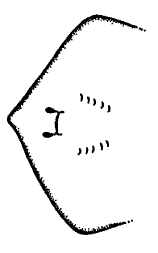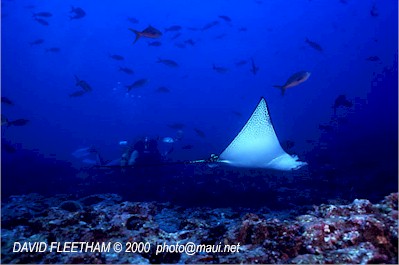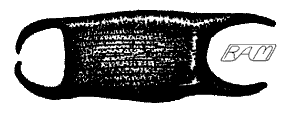Batoids: Sawfishes, Guitarfishes,
Electric Rays, Skates, and
Sting Rays — ±625 species
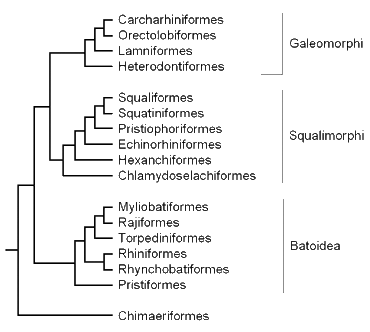
- body flattened dorsoventrally, with eyes and spiracles located on top of the head (the spiracles are often large and well-developed, being the major route for water intake during breathing while lying on the bottom)
- mouth ventral and transverse, often covered by a fleshy, curtain-like nasal flap
- five pairs of gill slits in most forms (six in Hexatrygonidae), located on the ventral surface
- pectoral fins greatly expanded and attached to the side of the head anterior to the gill openings (unlike those of the angel sharks, order Squatiniformes, in which the pectorals are separate from the head), giving the body a round or diamond shape
- anal fin absent
- caudal fin often reduced or absent (many of the rays have a long, whip-like tail lacking any vestige of fins)
- oviparous (egg-laying) to ovoviviparous
- most species are marine, but many can penetrate estuarine waterways and even fresh waters; one family of river stingrays (Potamotrygonidae, inhabiting South American rivers with an Atlantic drainage) is exclusively freshwater, having lost the ability to osmoregulate in the sea. Batoids are found in all oceans, from cold temperate to warm tropical zones, and from the surface to at least 9,840 feet (3,000 metres) in the Atlantic, Pacific, and Indian oceans
- 78 genera in 19 families and 6 orders
|
|
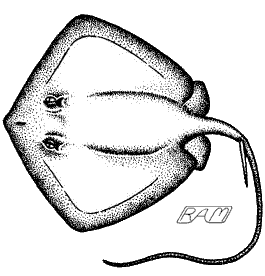 |
A representative batoid, the Southern Stingray (Dasyatis americana = Amphotistius longus?), showing the flattened, disc-like body with pectoral fins joined to the side of the head, ventral mouth and gill openings characteristic of the group.
| The batoids are highly successful flattened variations on the basic sharky theme. Yet — despite their marvelous diversity in form, behavior, and habitat — the batoids have received relatively little scientific attention and thus are poorly known compared with their more infamous cousins, the sharks. Yet even the most mush-mouthed, sedentary skate is as much a shark as the razor-toothed, super-predatory Great White (Carcharodon carcharias). |
|
The Spotted Eagle Ray (Aetobatus narinari) is one of the most beautiful and graceful of sea creatures, using its enlarged, wing-like pectoral fins to 'flap' through the water.
Photo © David Fleetham david@davidfleetham.com; used with the gracious permission of the photographer.
Most batoids swim by undulating or flapping their enlarged pectoral fins, but some (such as the sawfishes, guitarfishes, and torpedo rays) rely more on a shark-like sculling motion of a well-developed caudal fin. Some skates (especially the genera Cruriraja and Anacanthobatis) have a mobile, leg-like lobe on the forward edge of each pelvic fin and actually 'kick' themselves along as they glide over the bottom like flying saucers.
The batoids are remarkably diverse in their mode of reproduction. Skate egg cases are often rectangular with elongated tendrils at each corner, which serve to anchor them to bottom growth (washed ashore, the empty cases are known as "mermaid's purses"). Fetal electric rays (Torpediniformes) are nourished by protein-rich secretions from the uterine wall, while fetal stingrays (Myliobatiformes) get their nourishment delivered to them via secretions from pseudo-placentae that enter their bodies through the spiracles. Most batoids are benthic, lying on the substrate for extended periods, often partially buried. Some forms, however (notably the eagle, cownose, Manta and devil rays) are secondarily pelagic, swimming strongly in mid-water and rarely resting on the bottom.
Batoid taxonomy is presently undergoing major revisions. Some systematic workers — including Marcelo de Carvalho, Joseph Nelson, Kiyonori Nishida, and Shigeru Shirai — feel that the batoids should be lumped into a single order, Rajiformes. Other workers — including Leonard Compagno, Peter Last, and John McEachran — feel that the batoids should be split into five or six orders, although they differ somewhat on defining characters, species composition, and interrelationships of those orders. The scheme adopted here is highly provisional, based primarily on McEachran's (1996) work:
Order Pristiformes: Sawfishes — 7 species
Order Rhiniformes: Sharkfin Guitarfish — 1 species
Order Rhynchobatiformes: Shovelnose Guitarfishes — 60 species
Order Torpediniformes: Electric Rays — 69 species
Order Rajiformes: Skates — 283 species
Order Myliobatiformes: Stingrays — 205 species
